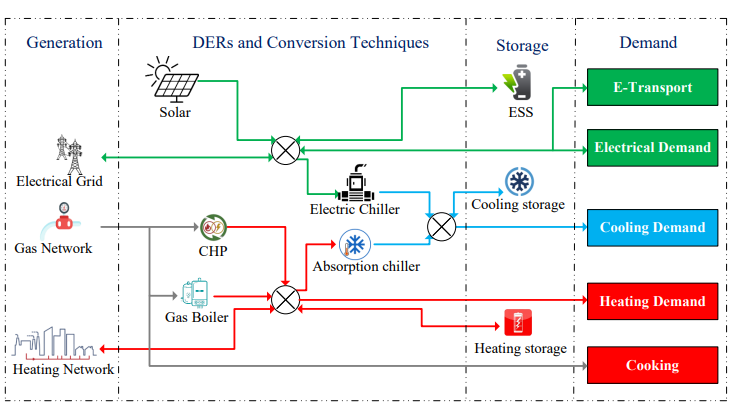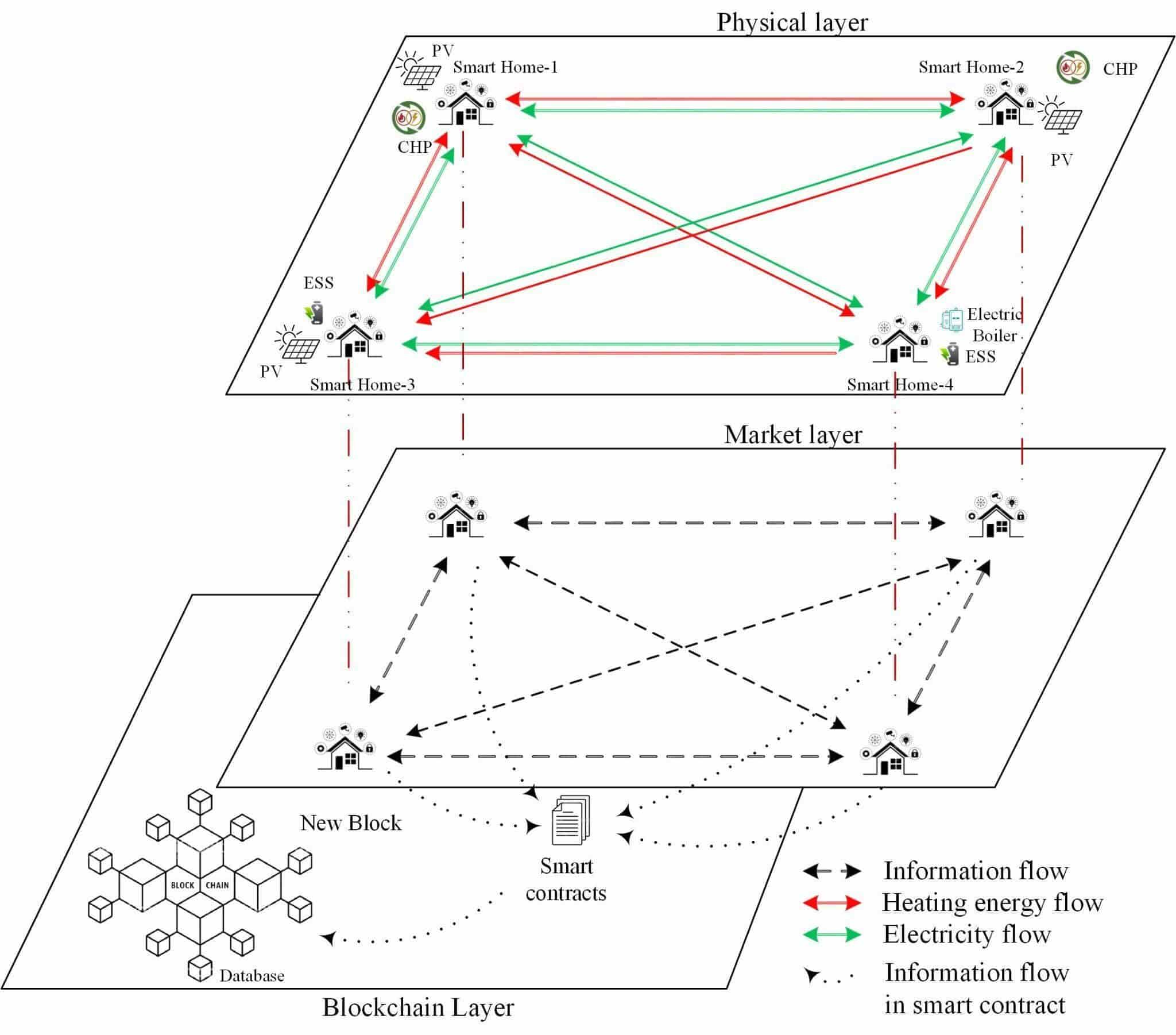Blockchain Technology Based Multi-Vector Energy Trading in Smart-Neighbourhoods
Written by Chandra Prakash Barala, Aaquib Firdous, Sumanth Yamujala, Parul Mathuria, and Rohit Bhakar
Energy systems are transforming towards decentralized operations, resulting in high penetration of Distributed Energy Resources (DERs). However, these localized generation pockets increase operational stress on upstream grids, with reverse power flow and reactive power control challenges. This necessitates additional network investment to ensure system security. Local energy management of DERs can minimize upstream grid feed-in and mitigate investment requirements. Neighbourhood energy sharing offers an effective technique for consumption of locally produced energy, as certain technologies like cogeneration, Power-to-Gas (P2G) and Power-to-Heat (P2H) are amenable to conversion, trade, and storage of various forms of energy in neighbourhoods. This requires a secure market framework where producers and consumers can negotiate and execute energy trades. Analogous to Peer-to-Peer (P2P) electricity trade, multi-energy P2P facilitates trading of various energy vectors like electricity, heating, cooling, and gas to meet diverse energy demands and limit carbon footprints. However, such a market mechanism must be complemented with a centralized entity and requires significant computations to be handled. Integrating Blockchain technology and smart contracts with the P2P trading can allow customers to buy-sell energy from each other in a decentralized way, without the need for a centralized entity to coordinate. In this work, we provide an overview of blockchain technology based multi-vector energy trading in smart-neighbourhoods to promote local energy balance.
Introduction
Traditional power systems satisfy significant energy demand by producing electricity at far-off places and transmitting it over large networks, incurring considerable emissions and losses. Modern power systems are getting dominated by Distributed Energy Resources (DERs), such as residential rooftop solar, energy storage systems, Combined Heat and Power (CHP), and heat pumps, and require decentralized operations. Energy policies are designed to incentivize DERs to inject electricity into the grid based on feed-in tariffs, thus encouraging renewable generation. However, integration of DERs at the distribution end pose dynamic challenges, like bidirectional power flow in case of excess generation and voltage violations. This requires infrastructure upgrades to avoid operational stress caused by unplanned and intermittent DER generation on the upstream grids. Addressing these challenges necessitates an improved system architecture to facilitate local energy production and its trade & consumption to promote local energy management. Neighbourhood energy sharing in this context can reduce operational stress on the upstream grid assets and offer opportunities to manage the energy demand locally. This can coordinate prosumers and trade energy at the lowest level and share its surplus, if any, to the upstream grid [1,2].
Meeting diverse energy requirements like heating/cooling, gas and electricity in different sectors like buildings, industries, and transport, require a holistic approach to limit carbon footprints through sustainable and cost-effective pathways. Neighbourhood energy systems with evolving technological transformations, like flexible Power-to-Heat (P2H), Power-to-Gas (P2G), and cogeneration units, can cater energy needs of various forms. It thus becomes imperative to define clear strategies that consider other energy vectors along with electricity, in the form of Multi-Energy Systems (MES) [3]. MES can help to exploit synergies that exist in different energy systems, which were earlier managed and operated independently. Therefore, MES, in this perspective, becomes a candidate solution to facilitate diverse energy demand balancing, reducing the dependence on upstream energy grids and enhancing utilization of heterogeneous DERs (PV, Wind, CHPs), as illustrated in Figure 1 [2,3]. However, the major challenge lies in trading surplus/deficit heating, cooling, and electricity vectors among various users connected to the network. Multi-energy P2P energy trading, analogous to electricity P2P trading, can allow trading/sharing energy among smart-neighbourhoods with minimum losses (closely placed peers). This can enhance techno-economic benefits, like (1) Reduction in operational stress on upstream and downstream systems, (2) Flexible and resilient system operations, (3) Increase in DER adoption, (4) Minimization of network operation and investment cost, and (5) Reduction in carbon footprint.

Figure 1. Multi-Energy Interactions
Blockchain Based P2P Trading System
P2P trading can provide the necessary flexibility to system operators on the regional/community and national level. Optimal management and coordination of DERs through P2P markets can facilitate their full-scale usage and participation in markets, and hence improve system reliability. Despite the opportunities and benefits that P2P trading can bring to the energy system, practical challenges related to third-party involvement cost, data storage, security, and complexity of financial settlements hinders its full-scale implementation. The P2P market structure needs to be integrated with an authentic layer capable of recording all the transactions in an efficient, unaltered, transparent and tamper-proof manner, while reducing the additional cost incurred per transaction. This can enhance delivery of automated trading, efficient billing systems, energy costs, and price signals to all prosumers, thus increasing their efficiency and participation in local energy trading.
In this perspective, Blockchain technology is evolving as a promising platform to provide value in the transparent exchange of energy and data. It is a natural fit for P2P energy trading systems. P2P trading using blockchain technology with smart contracts eliminates the need for a third-party to balance and manage trade, thus ensuring faster settlements at reduced transaction cost [4,5].
Blockchain based Multi-vector P2P neighbourhood energy trading can have the following layers (Figure 2):
- Physical Layer: The physical layer reflects the energy trading market's physical structure. It consists of the distribution system components and multiple smart homes connected through electric, heat and gas networks, which have direct information and energy transfer connections with one another.
- Market Layer: The main components of the market layer are communication networks and devices, Information flow, etc. In the market layer, prosumers can negotiate and execute energy trades using the P2P framework.
- Blockchain Layer: The Blockchain layer, which includes the user interface and decentralized applications (DApps), is where the user interacts with the smart contracts, enters information related to energy requirements and settles the financial transactions. This layer helps to maintain vital data and ensures data security.
Smart homes having DERs, heating and cooling loads are the key actors of the multi-vector energy trading among neighbourhoods. This trading in neighbourhood environment becomes more feasible due to reduced losses in energy sharing between closely placed peers. With the advancements in smart city architecture, the users tend to be more aware of the energy consumption at their level. This allows them to change their role into active users in the local network. The users can optimize and alter their energy consumption as per the motive of the community and trade the net energy with other peers in different networks. The market layer uses the P2P framework and matches the peers as per the energy requirements and availability, and trades the net energy with other peers using different networks like electricity, heat, and gas. Once the peer is matched, the blockchain based interface executes the financial transactions, while ensuring the privacy of financial transactions.

Figure 2. Multi-Energy Trading Layers
Conclusion:
Neighbourhood energy trading of various energy vectors like heating, cooling, gas, and electricity, can relieve the operational stress on upstream electrical networks, allowing demand balancing at regional levels and incentivizing prosumers. However, these complex trading arrangements need decentralized, robust, transparent and tamper-proof platforms to ensure secure and fair-trading arrangements. The blockchain technology can allow data storage and ensure efficient P2P trading of various energy vectors in a multi energy integration perspective. However, market regulations, efficient real-time trading mechanisms, cyber security challenges, and smart energy management frameworks, are needed to allow for optimal utilization of localized energy resources and reduce carbon footprints.
References:
- A. Rajaei, S. Fattaheian-Dehkordi, M. Fotuhi-Firuzabad, M Moeini-Aghtaie, “Decentralized transactive energy management of multi-microgrid distribution systems based on ADMM,” Int. J of Elect. Power and Energy Syst., vol. 132, p. 107126, 2021.
- S. Cui, Y. Wang and J. Xiao, "Peer-to-peer energy sharing among smart energy buildings by distributed transaction," IEEE Trans. Smart Grid, vol. 10, no. 6, pp. 6491-6501, 2019.
- A. Mantri, A. Firdous, C. P. Barala, R. Bhakar and P. Mathuria, "Evolution of integrated multi-energy vector systems and innovation opportunities," 9th IEEE Int. Conf. Power Syst. (ICPS), pp. 1-6, 2021.
- T. AlSkaif, J. L. Crespo-Vazquez, M. Sekuloski, G. van Leeuwen and J. P. S. Catalão, "Blockchain-based fully peer-to-peer energy trading strategies for residential energy systems," IEEE Trans. Industrial Info., vol. 18, no. 1, pp. 231-241, 2022.
- Y. Esmat, M. de Vos, Y. Ghiassi-Farrokhfal, P. Palensky, and D. Epema, “A novel decentralized platform for peer-to-peer energy trading market with blockchain technology,” Applied Energy, vol. 282, p. 116123, 2021.
This article was edited by Shafi Khadem
To view all articles in this issue, please go to January 2022 eNewsletter. For a downloadable copy, please visit the IEEE Smart Cities Resource Center.





To have the eNewsletter delivered monthly to your inbox, join the IEEE Smart Cities Community.
Past Issues
To view archived articles, and issues, which deliver rich insight into the forces shaping the future of the smart cities. Older eNewsletter can be found here. To download full issues, visit the publications section of the IEEE Smart Cities Resource Center.



